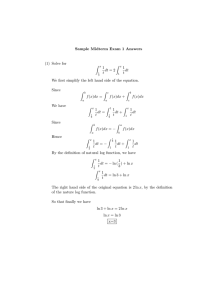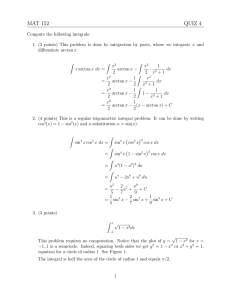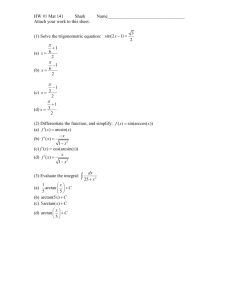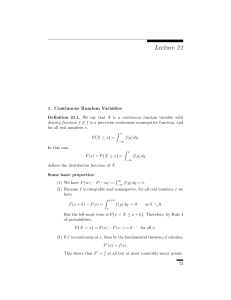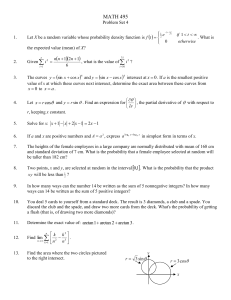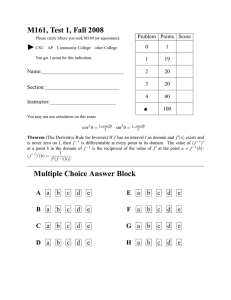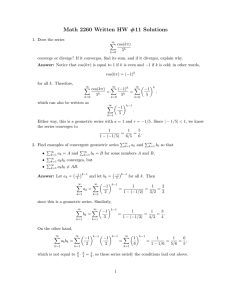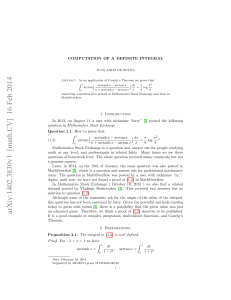(x'&=-r)
advertisement
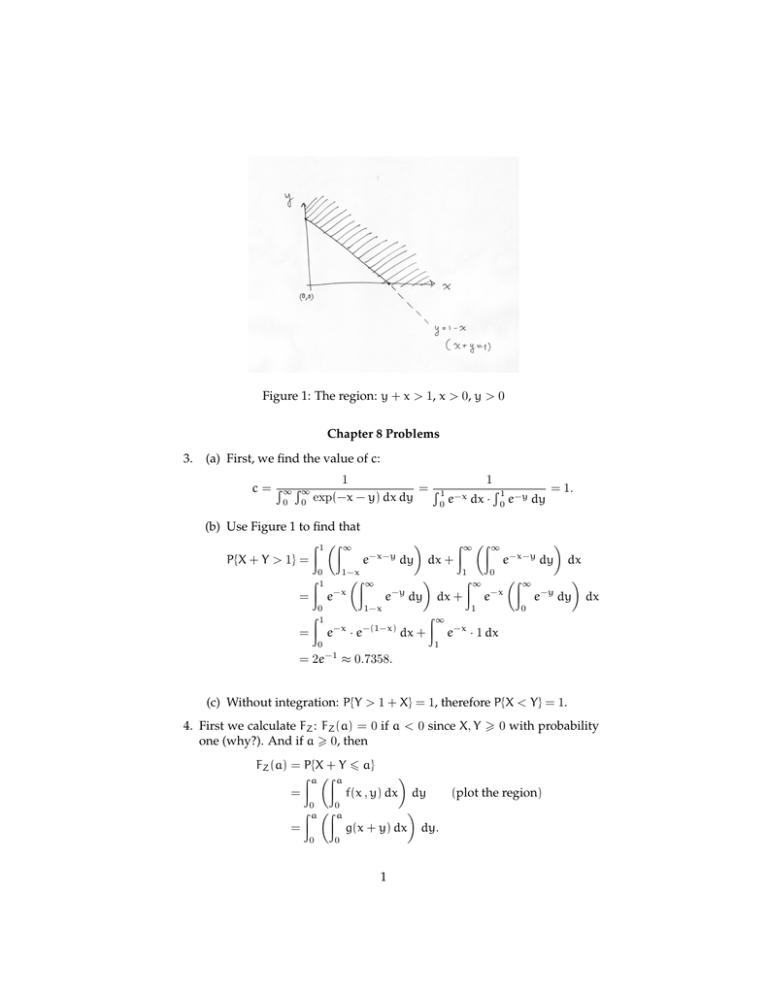
(oro)
V=r*x
(x'&=-r)
Figure 1: The region: y + x > 1, x > 0, y > 0
Chapter 8 Problems
3.
(a) First, we find the value of c:
c = R∞ R∞
0
0
1
1
= 1.
= R1
R1
−x
exp(−x − y) dx dy
dx · 0 e−y dy
0e
(b) Use Figure 1 to find that
Z ∞ Z ∞
Z 1 Z ∞
−x−y
−x−y
e
dy dx
e
dy dx +
P{X + Y > 1} =
1
0
0
1−x
Z ∞
Z ∞
Z∞
Z1
e−y dy dx
e−x
e−y dy dx +
= e−x
0
1−x
Z1
e−x · e−(1−x) dx +
=
Z∞
1
0
e−x · 1 dx
1
0
= 2e−1 ≈ 0.7358.
(c) Without integration: P{Y > 1 + X} = 1, therefore P{X < Y} = 1.
4. First we calculate FZ : FZ (a) = 0 if a < 0 since X, Y > 0 with probability
one (why?). And if a > 0, then
FZ (a) = P{X + Y 6 a}
Z a Z a
=
f(x , y) dx dy
(plot the region)
0
0
Z a Z a
=
g(x + y) dx dy.
0
0
1
G-
\f,n'$
w
Figure 2: The region between: 0 < y < a and y < z < a + y
In order to calculate the inner integral: Fix y between zero and a and
change variables [z := x + y] to find that
Z a+y
Za
g(z) dz.
g(x + y) dx =
0
y
Therefore [see Figure 2],
Z a Z a+y
g(z) dz dy
FZ (a) =
0
Za
y
Z z
dy
g(z)
=
0
Za
Z 2a
0
Z a
dy
g(z)
dz +
dz
z−a
a
Z 2a
(2a − z)g(z) dz
Z 2a
Z 2a
zg(z) dz.
g(z) dz −
zg(z) dz + 2a
zg(z) dz +
=
0
Za
=
a
0
a
a
Differentiate [d/da] to find that if a < 0, then fZ (a) = 0; else if a > 0,
then
Z 2a
fZ (a) = ag(a) + 2
g(z) dz + 2a {g(2a) − g(a)} − 2ag(2a) − ag(a)
a
Z 2a
=2
g(z) dz − 2ag(a).
a
[The fundamental theorem of calculus] We can slightly simplify the latter:
R2a
fZ (a) = 2 a {g(z) − g(a)} dz.
6. We write
w(x , y) = x2 + y2
2
and
z(x , y) = y/x.
√
Then r := w and θ := arctan(z) define (x , y) in polar coordinates. That
is,
√
√
x = w cos(arctan z)
and
y = w sin(arctan z).
Then, the Jacobian of this transformation is
J(w , z) =
∂x ∂y ∂x ∂y
−
.
∂w ∂z
∂z ∂w
But
∂x
∂w
∂x
∂z
∂y
∂w
∂y
∂z
1
= √ cos(arctan z)
2 w
√ sin(arctan z)
=− w
1 + z2
1
= √ sin(arctan z)
2 w
√ cos(arctan z)
= w
.
1 + z2
Therefore,
J(w , z) =
1
.
2(1 + z2 )
Consequently,
fW,Z (w , z) = fX,Y (x(w , z) , y(w , z)) × |J(w , z)|.
Because x2 (w , z) + y2 (w , z) = w2 ,
fX,Y (x(w , z) , y(w , z)) =
and so
fW,Z (w , z) =
c
,
(1 + w2 )3/2
c
2(1 +
w2 )3/2 (1
+ z2 )
,
for w > 0 and −∞ < z < ∞. Else, fW,Z (w , z) = 0. We can write
fW,Z (w , z) =
cπ
1
×
,
π(1 + z2 )
2(1 + w2 )3/2
w > 0, −∞ < z < ∞.
Therefore, W and Z are independent with
fZ (z) =
1
π(1 + z2 )
and
fW (w) =
(i.e., Z is Cauchy),
cπ
,
2(1 + w2 )3/2
3
w > 0.
It remains to find c [this is a part of #5]. Clearly,
c=
π
R∞
0
2
.
(1 + w2 )−3/2 dw
In order to compute the integral, change variables [a = 1/(1 + w2 )] to
find that
Z∞
Z
1 1 da
dw
√
=
= 1.
2 3/2
2 0 1−a
0 (1 + w )
Therefore, c = 2/π.
4

